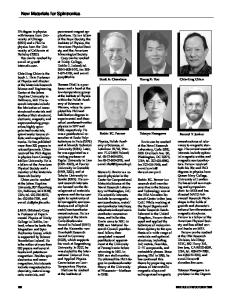A New Force-Displacement Model for Continuous Indentation of Bilayer Materials
- PDF / 271,792 Bytes
- 6 Pages / 612 x 792 pts (letter) Page_size
- 5 Downloads / 268 Views
A New Force-Displacement Model for Continuous Indentation of Bilayer Materials A. Nayebi, R. El Abdi, G. Mauvoisin and O. Bartier University of Rennes Applied Mechanics Research Laboratory I.U.T. de Rennes. 3, rue du Clos Courtel - B.P. 90422-35704 Rennes Cedex 7, France ABSTRACT A new relationship between indentation load and depth in relation to flow stress and strain hardening exponents of film and substrate of bilayers is given. The comparison between the numerical results and those experimentally obtained from known materials, confirms the interest of the proposed model for film characterization of these materials. INTRODUCTION The indentation of bilayers is considerably complex, where the contact field can be strongly influenced by elasto–plastic mismatch between the film and substrate materials. In order to obtain indentation load-depth relation, we need to understand how the mechanical properties of the substrate affect measurements of indentation load-depth [1]. Empirical or semi-empirical models have been developed in an attempt to explain such depth dependence of indentation load-depth curve and hardness but these models are limited to a number of bilayer materials [2]. In this paper, a new mixture law which determines the effect of substrate on large film indentations and a new indentation load-depth relation has been introduced. Using this new law, the mechanical and geometrical properties of nitrided steels which can be considered as bilayer materials (figure 1), are related.
HV 0.1 Kg
1400 1200
Film
1000 800 600
Substrate
Vickers indentation results
Linear approximation
400 200 0 0
0.05
0.1
0.15
0.2
Depth (mm) Figure 1. Hardness profile of a bilayer (Nitrided X15CrNi17-03 steel).
L6.5.1
FINITE ELEMENT SIMULATION An elastic sphere indenting an elasto-plastic axisymmetric half-space bilayer under normal contact, was considered and modeled with the CASTEM 2000 finite element program. The finite element mesh with 6316 quadratic elements, 5986 nodes and the specified boundary conditions used in the simulations, are shown in figure 2. Other mesh shapes and densities were tested and results were identical. The same Hollomon’s behavior law (equation 1) is used for the film and the substrate materials in the finite element program. σ = E ε if σ < σy (1) n
σ = K ε if σ > σy where ε is the total strain and n the strain hardening exponent. The finite element simulations give the plastic strain distribution ε pl , which is used in the proposed model presented below. NEW MIXTURE LAW The indentation depth - applied load relation for a homogenous material has been determined by finite element simulations as [3]: F = A(n,σy). δ B(n,σy)
(2)
We propose a new mixture law which takes into account the film and substrate influence (equation 3) relating film and substrate properties during indentation by defining the influence parameter α:
δ b = α δ f + (1 − α ) δ s
(3)
δ f represents only film indentation depth, δ s represents only substrate indentation depth and δ b is the real indenter displacement o
Data Loading...











